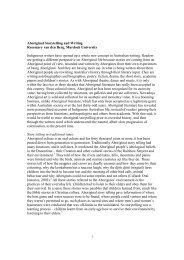Big Chief Little Wolf: Wrestling, Radio and Folklore in ... - [API] Network
Big Chief Little Wolf: Wrestling, Radio and Folklore in ... - [API] Network
Big Chief Little Wolf: Wrestling, Radio and Folklore in ... - [API] Network
You also want an ePaper? Increase the reach of your titles
YUMPU automatically turns print PDFs into web optimized ePapers that Google loves.
Barry York<br />
This was his last bout. More ill-health <strong>and</strong> strokes followed <strong>and</strong> <strong>in</strong> the early 1960s<br />
he was admitted to Mount Royal Hospital <strong>in</strong> Parkville, Melbourne. He rema<strong>in</strong>ed<br />
there for n<strong>in</strong>eteen years until his return to the US. Out of sight but def<strong>in</strong>itely not out<br />
of m<strong>in</strong>d, he was a genu<strong>in</strong>e folk-hero.<br />
I grew up <strong>in</strong> Brunswick, which borders the suburb of Parkville <strong>and</strong> perhaps it<br />
was due to that close proximity that ‘<strong>Big</strong> <strong>Chief</strong> <strong>Little</strong> <strong>Wolf</strong>’ was a household <strong>and</strong><br />
playground name <strong>in</strong> my suburb, even to a generation who had never seen him wrestle.<br />
Whenever my mates <strong>and</strong> I would play ‘Cowboys <strong>and</strong> Indians’, we would draw<br />
straws to see who would be ‘<strong>Big</strong> <strong>Chief</strong> <strong>Little</strong> <strong>Wolf</strong>’. The contradiction <strong>in</strong> the name<br />
— ‘<strong>Big</strong>’ <strong>and</strong> ‘<strong>Little</strong>’ — appealed, as did the whole notion of a real live Navajo<br />
Indian be<strong>in</strong>g <strong>in</strong> our midst. The name was always there, <strong>in</strong> the air. Yet while we<br />
were play<strong>in</strong>g our games, the real man, who had been baptised by Spanish missionaries<br />
as ‘Ventura Tenario’, was languish<strong>in</strong>g just down the road — semi-paralysed, <strong>in</strong> a<br />
wheelchair, his face twisted, the lid of one eye taped to an eyebrow to keep it open.<br />
About thirty years later, <strong>in</strong> the early 1990s, even though the <strong>Chief</strong> had been dead<br />
for about a decade, it bemused me to f<strong>in</strong>d that his name still hummed <strong>in</strong> the air for<br />
people of a certa<strong>in</strong> generation. I began casually test<strong>in</strong>g the hypothesis that he was<br />
a folk-hero. I’d ask people — cleaners, housewives, taxi-drivers, doctors, academics<br />
— whether they’d heard of him. What, if anyth<strong>in</strong>g, did the name mean to them? As<br />
a Research Fellow at the Australian National University, my work enabled me to<br />
travel between Canberra, Melbourne <strong>and</strong> Sydney. In each place, virtually everyone<br />
— n<strong>in</strong>ety percent of the right age-group — not only had heard of him but had a story<br />
to tell about him. It was extraord<strong>in</strong>ary. Then, <strong>in</strong> 1994, I took a plunge. I decided to<br />
test the waters more widely. Perhaps there was a book <strong>in</strong> this! I sent out letters to<br />
editors of daily <strong>and</strong> local newspapers <strong>and</strong> made an appearance on Bert Newton’s<br />
Good Morn<strong>in</strong>g Australia, seek<strong>in</strong>g rem<strong>in</strong>iscences about the <strong>Chief</strong>. The response<br />
was overwhelm<strong>in</strong>g. Over a period of five months, I received approximately 700<br />
letters from the public. Aga<strong>in</strong>, each writer not only remembered the <strong>Chief</strong> but<br />
wanted, <strong>in</strong> some way, big or small, to connect their life to his. There were former<br />
wrestlers who had wrestled him, <strong>and</strong> there were nurses who had nursed him. In<br />
between, there were hundreds of people who had seen him wrestle or caught his<br />
side-show, or who had just met him by chance <strong>in</strong> the street or <strong>in</strong> a restaurant, pub,<br />
shop or c<strong>in</strong>ema.<br />
Professional wrestl<strong>in</strong>g <strong>in</strong> Australia is someth<strong>in</strong>g to which historians haven’t paid<br />
much attention; yet it was, on the whole, more popular than box<strong>in</strong>g. There are quite<br />
a few good histories of box<strong>in</strong>g <strong>and</strong> boxers <strong>in</strong> Australia, but so far noth<strong>in</strong>g about<br />
wrestlers <strong>and</strong> wrestl<strong>in</strong>g, save for Libnan Ayoub’s recent record book, 100 Years of<br />
Australian Professional <strong>Wrestl<strong>in</strong>g</strong> (Topmill, Marrickville, 1998). Perhaps wrestl<strong>in</strong>g<br />
is difficult to look at academically because it is hard to categorise; box<strong>in</strong>g, like it or<br />
not, is a sport. <strong>Wrestl<strong>in</strong>g</strong>, well, wrestl<strong>in</strong>g is a, er, well ... what is it exactly?! Is it a<br />
sport? Is it just act<strong>in</strong>g? My Pocket Oxford Dictionary def<strong>in</strong>es ‘sport’ as ‘fun or<br />
diversion, a pastime of an outdoor or athletic k<strong>in</strong>d’. <strong>Wrestl<strong>in</strong>g</strong> is certa<strong>in</strong>ly fun, <strong>and</strong> it<br />
can <strong>in</strong>volve considerable athleticism. The problem, of course, is that the outcome of<br />
n<strong>in</strong>ety-n<strong>in</strong>e percent of matches is known <strong>in</strong> advance, which is very ‘non-sport<strong>in</strong>g’.<br />
That, <strong>in</strong>cidentally, is why spectator gambl<strong>in</strong>g has rarely been associated with wrestl<strong>in</strong>g<br />
this century. Interest<strong>in</strong>gly, the dictionary def<strong>in</strong>es ‘sport<strong>in</strong>g’ <strong>in</strong> a way that means<br />
there has to be reasonable odds <strong>in</strong>volved <strong>in</strong> the activity. Professional wrestl<strong>in</strong>g may<br />
thus be described as a ‘non-sport<strong>in</strong>g sport’! But, ultimately, I like to describe it as<br />
30


![Big Chief Little Wolf: Wrestling, Radio and Folklore in ... - [API] Network](https://img.yumpu.com/12204748/2/500x640/big-chief-little-wolf-wrestling-radio-and-folklore-in-api-network.jpg)
![Dream and Nightmare in William Gibson's ... - [API] Network](https://img.yumpu.com/49298598/1/184x260/dream-and-nightmare-in-william-gibsons-api-network.jpg?quality=85)

!['Fuck All Editors': The Ern Malley Affair and Gwen ... - [API] Network](https://img.yumpu.com/42446228/1/184x260/fuck-all-editors-the-ern-malley-affair-and-gwen-api-network.jpg?quality=85)
![Polona Petek - [API] Network](https://img.yumpu.com/40542952/1/190x245/polona-petek-api-network.jpg?quality=85)
![to download as a PDF. - [API] Network](https://img.yumpu.com/35170825/1/184x260/to-download-as-a-pdf-api-network.jpg?quality=85)
![Edward Koiki Mabo: The Journey to Native Title - [API] Network](https://img.yumpu.com/33197148/1/184x260/edward-koiki-mabo-the-journey-to-native-title-api-network.jpg?quality=85)
![Gallipoli, Kokoda and the Making of National Identity - [API] Network](https://img.yumpu.com/31766380/1/184x260/gallipoli-kokoda-and-the-making-of-national-identity-api-network.jpg?quality=85)
![Indigenous Knowledge and Pharmaceuticals - [API] Network](https://img.yumpu.com/24108846/1/184x260/indigenous-knowledge-and-pharmaceuticals-api-network.jpg?quality=85)
![Ferals: Terra-ism and Radical Ecologism in Australia - [API] Network](https://img.yumpu.com/13809010/1/184x260/ferals-terra-ism-and-radical-ecologism-in-australia-api-network.jpg?quality=85)
![Dark Tourism and the Celebrity Prisoner - [API] Network](https://img.yumpu.com/4348795/1/184x260/dark-tourism-and-the-celebrity-prisoner-api-network.jpg?quality=85)